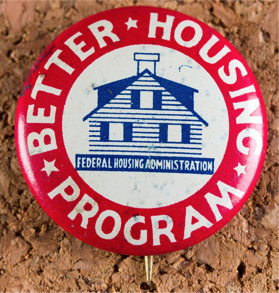Physical Address
304 North Cardinal St.
Dorchester Center, MA 02124
Physical Address
304 North Cardinal St.
Dorchester Center, MA 02124

The government exercises tremendous power over residential design in the US. Its influence is nearly invisible, because it works through complex financing programs, insurance incentives, and secondary markets. These mechanisms go unnoticed, but their effect is hard to miss—they remade the United States into a nation of sprawling suburbs. This is the second post in a series about government policies that encouraged suburban growth in the US. You can find the first post here. What image springs to mind when you picture “federally subsidized housing”? Most people imagine a low-income public housing tower, a homeless shelter, or a shoddy apartment building. Nope—suburban homeowners are the single biggest recipient of housing subsidies. As a result, suburbs dominate housing in the United States. For decades, federal finance regulations incentivized single-family homes through three key mechanisms: Insurance, National mortgage markets, and New standards for debt structuring The housing market hides these details from the typical home buyer. As a result, most people are unaware of these subsidies. But their effects are striking—they determined the location and shape of development across America for generations. A New Deal to restore the housing industry Debt has a negative connotation these days. Credit cards, student loans, and auto loans are the anchors that keep many Americans in debt for most of their life. Meanwhile, we view mortgages very differently—they are seen as an investment, a symbol of adulthood, and a sign of financial stability. This was not always the case. In the early 1900s, mortgages were just like any other kind of debt. Nowadays payments are spread out over decades, but back then they came due all at once after a few years. Most people didn’t have enough cash at the end of the term. It was standard to pay back some and negotiate a new loan for […]
1. Shocker: The federal government is too incompetent to even sell its own buildings. Eh, oh well – it’s not like it holds most of that property in the city with the most expensive office space in America or anything. 2. Two State Senators from Queens are calling plans to toll the East River Bridges in exchange for relieving Long Island and Hudson Valley counties of the need to pay the MTA pay roll tax “nothing more than another tax on Middle Class families and small businesses.” First of all, it’s not a tax, it’s a user fee, but secondly, how many Middle Class (in caps, for christsake!) families are we supposed to believe really have to drive into Manhattan? 3. The FHA is loaning money to people with “less than stellar credit” to buy condos in New York City with only a 3.5% downpayment. In December I blogged an article claiming the federal government is shifting its subprime portfolio back to the FHA from Fannie Mae and Freddie Mac, whose implosion has cost taxpayers $150 billion. 4. Green roofs: Is there anything they can’t do? This report lists a whole slew of financial benefits, but if they’re such a great deal, why do developers need “significant public policy support” to install them? All the talk of creating jobs without even attempting to make a cost/benefit analysis is also disconcerting, but is typical of boosters of government programs. And are we really to believe that green roofs “reduce crime”? And if they really “improve property values for nearby buildings by 11 percent,” then why aren’t landlords falling over themselves offering to pay neighbors to install green roofs on their buildings? Seems like for such a supposedly huge benefit and relatively small number of beneficiaries, the collective action problem could be […]
From Rationalitate – The WaPo finally realizes the root cause of the subprime crisis Agencies like FHA and HUD, and pseudo-private agencies like Fannie Mae and Freddie Mac, were the government’s tool to manipulate the market for mortgages, and manipulate it they did: 40% of all mortgages are financed by lending companies Fannie Mae and Freddie Mac, which hold $5.3 trillion in outstanding debt, and receive tax breaks (read: subsidies) to the tune of $6.5 billion a year. Part of the irony of Bush’s “ownership society” is that it requires taxpayers to fund it. While on its face home ownership might seem like the paragon of private property and private ownership, it’s really not in very high demand in the actual free market. While America does indeed have very high rates of homeownership, it’s in spite of the market, not because of it. (I don’t really agree with the phrasing, “it’s not really in high demand.” I think almost all people desire to own their dwelling, but at a price that makes sense for them.) “Experts” often say how important it is for people to “own” their homes. I agree that ownership is great. But, at what cost? Market distortions that create bubbles? Wealth transfers from the less fortunate and landlords to “owners” of homes? “Ownership” isn’t best for everyone, especially the “owners” of a junk loan…